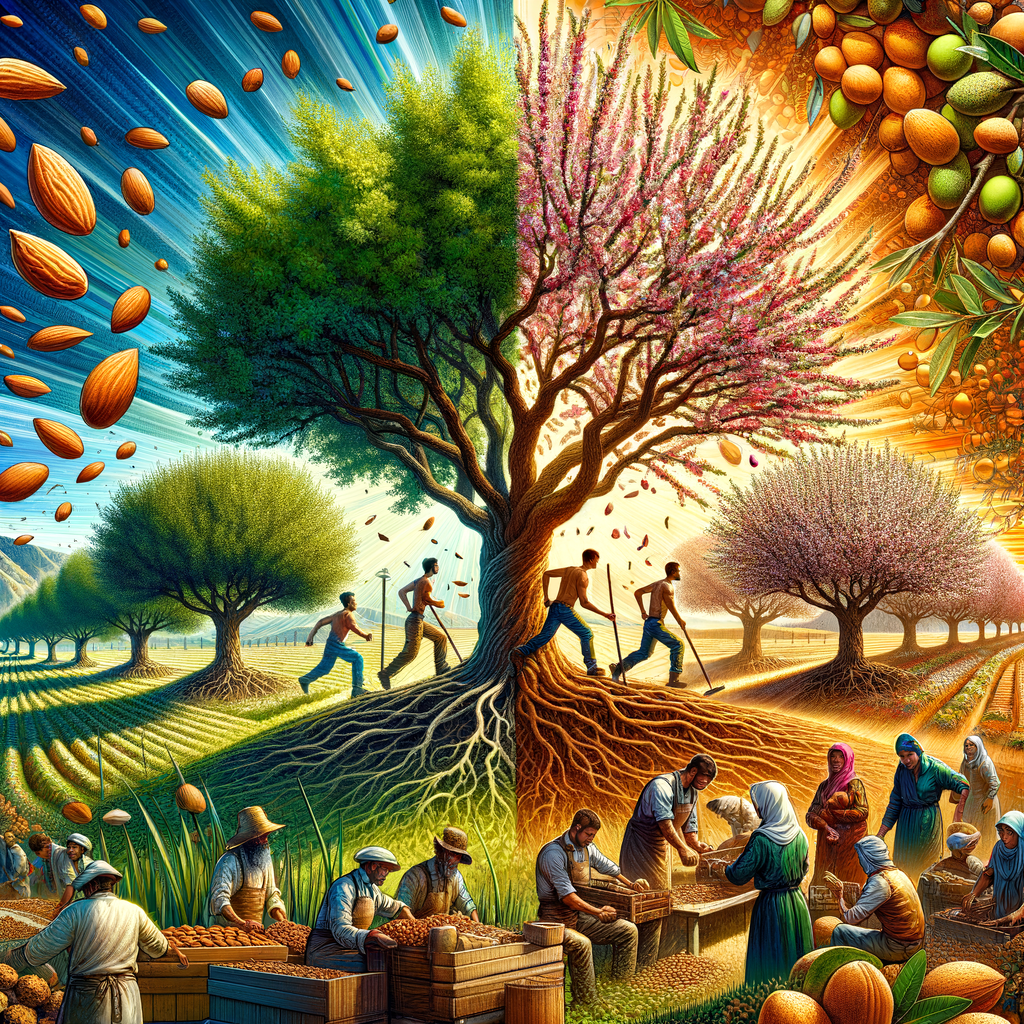
Introduction to Almond Trees
Almond trees are fascinating plants with a rich history and a significant role in many local ecosystems. In this section, we will provide an overview of almond trees and discuss their importance in local ecosystems.
-
- Overview of Almond Trees
Almond trees, scientifically known as Prunus dulcis, are native to the Middle East and South Asia. They are medium-sized trees that typically grow between 13 and 33 feet tall. The almond tree is best known for its fruit, the almond, which is actually not a true nut but a drupe. This means it has an outer hull and a hard shell with the seed inside.
Almond trees are deciduous, meaning they lose their leaves in the fall and grow new ones in the spring. They are also known for their beautiful white and pink flowers that bloom in early spring.
-
- Importance of Almond Trees in Local Ecosystems
Almond trees play a vital role in many local ecosystems. They provide food and habitat for a variety of wildlife, including birds, insects, and small mammals. Their flowers are a valuable source of nectar for bees, which in turn help pollinate the almond trees and other plants in the area.
Almond trees also contribute to soil health. Their roots help prevent soil erosion, and fallen almond leaves add nutrients back into the soil as they decompose. Additionally, almond trees can help improve air quality by absorbing carbon dioxide and releasing oxygen.
In the following sections, we will delve deeper into the almond tree ecosystem, the impact of almond trees, and provide case studies highlighting their role in local ecosystems. Stay tuned to learn more about these unsung heroes of local ecosystems.
Almond Tree Ecosystem
Understanding the Almond Tree Environment
Almond trees are a vital part of our ecosystem. They provide not only delicious nuts but also play a significant role in the environment. To understand how almond trees thrive, we need to delve into their climate and soil requirements.
-
- Climate requirements for almond tree cultivation
Almond trees need a specific climate to grow and produce nuts. They prefer a Mediterranean climate, which means they thrive in warm, dry summers and mild, wet winters. The trees need plenty of sunlight, at least 6 hours a day, and a long, frost-free season. Almond trees also require a chilling period during winter, with temperatures between 33 and 45 degrees Fahrenheit, to ensure they bloom properly in the spring.
-
- Soil requirements for almond tree cultivation
As for the soil, almond trees prefer well-drained, deep soils with a pH level between 6 and 7.5. They can tolerate a variety of soil types, including sandy, loamy, and clay soils, as long as the soil is well-drained. Almond trees are quite resilient and can tolerate slightly saline soils, but they do not do well in waterlogged conditions.
In conclusion, understanding the environment of the almond tree is crucial for its successful cultivation. By providing the right climate and soil conditions, we can ensure the healthy growth of these trees and their continued contribution to our ecosystem.
Almond Tree Biodiversity
Almond trees are more than just a source of delicious nuts. They are a vital part of their ecosystem, providing a habitat for a variety of creatures and helping to maintain biodiversity. Let’s explore this in more detail.
-
- Flora and Fauna Associated with Almond Tree Habitats
Almond trees, with their lush foliage and fragrant blossoms, create a welcoming environment for a variety of creatures. Birds, such as sparrows and finches, often nest in the branches, while insects, including bees and butterflies, are attracted to the nectar of the almond blossoms. Even mammals, like squirrels and rabbits, find shelter under the almond tree’s broad canopy.
These trees also support a variety of plant life. Their fallen leaves create a nutrient-rich soil that is ideal for the growth of smaller plants and flowers. This creates a mini-ecosystem, where different species interact and support each other.
-
- Role of Almond Trees in Maintaining Biodiversity
Almond trees play a crucial role in maintaining biodiversity. By providing food and shelter to a variety of species, they help to support a balanced ecosystem. The presence of almond trees can also help to prevent soil erosion, as their roots hold the soil together, preventing it from being washed away by rain or wind.
Furthermore, almond trees are a key player in pollination. Bees and other insects that visit the almond blossoms for nectar carry pollen from tree to tree, aiding in the fertilization process. This not only helps the almond trees to produce nuts but also supports the reproduction of other plant species in the area.
In conclusion, the biodiversity of almond tree habitats is a testament to the important role these trees play in their ecosystems. They provide a home for a variety of species, contribute to soil health, and aid in pollination, making them a vital part of maintaining biodiversity.
Impact of Almond Trees
Almond trees have a significant impact on both the environment and society. Let’s delve into the details of these effects.
Almond Tree Farming Impact
Almond tree farming is a major industry, particularly in places like California, where it contributes significantly to the economy. However, it also has important implications for the environment and local communities.
-
- Environmental impacts of almond tree farming
Almond tree farming can have both positive and negative environmental impacts. On the positive side, almond trees help improve air quality by absorbing carbon dioxide, a greenhouse gas. They also provide habitat for various species of wildlife, contributing to biodiversity.
On the negative side, almond tree farming requires a lot of water. In fact, it takes about a gallon of water to grow a single almond. This can strain water resources, especially in areas prone to drought. Additionally, the use of pesticides in almond farming can harm non-target species and pollute waterways.
-
- Socio-economic impacts of almond tree farming
Almond tree farming also has significant socio-economic impacts. It creates jobs and contributes to the economy, particularly in regions where almonds are a major crop. In California, for example, the almond industry supports over 100,000 jobs and contributes $11 billion annually to the state’s economy.
However, the industry also faces challenges. The high water needs of almond trees can lead to conflicts over water rights. Additionally, the reliance on bees for pollination means that declines in bee populations could threaten the industry’s future.
In conclusion, while almond tree farming has many benefits, it also presents certain challenges. It’s important for farmers, policymakers, and consumers to work together to ensure that this industry is sustainable and beneficial for all.
Influence of Almond Trees on Ecosystem
Almond trees, like other plants, play a significant role in maintaining the health and balance of our ecosystems. They contribute to soil health and air quality, two essential aspects of a thriving ecosystem. Let’s delve into these aspects in more detail.
- Almond Trees and Soil Health
Almond trees have a profound impact on soil health. Their extensive root systems help to stabilize the soil, preventing erosion and maintaining soil structure. Additionally, the leaves and nuts that fall from the trees decompose and enrich the soil with organic matter, improving its fertility and water-holding capacity.
According to a study, almond trees can increase the soil’s organic carbon content by up to 12%. This is significant because organic carbon is a key indicator of soil health and fertility. It supports the growth and activity of beneficial soil organisms, which in turn contribute to nutrient cycling and disease suppression.
- Almond Trees and Air Quality
Almond trees also contribute to air quality. They absorb carbon dioxide, a greenhouse gas, from the atmosphere and store it in their wood and roots. This process, known as carbon sequestration, helps to mitigate climate change.
Moreover, almond trees release oxygen into the atmosphere, which is essential for human and animal life. They also filter out harmful pollutants from the air, such as dust and particulate matter, improving air quality and human health.
In conclusion, almond trees play a vital role in maintaining the health and balance of our ecosystems. They contribute to soil health and air quality, making them an important part of our natural environment.
| Almond Trees Impact on Ecosystem | Details |
|---|---|
| Soil Health | Stabilize soil, prevent erosion, enrich soil with organic matter, improve soil fertility and water-holding capacity. |
| Air Quality | Absorb carbon dioxide, release oxygen, filter out harmful pollutants. |
Case Studies: Almond Trees and Local Ecosystems
Let’s take a closer look at how almond trees interact with their surroundings. We will examine two case studies that highlight the role of almond trees in local ecosystems.
-
Case Study 1: Almond Tree Cultivation and Its Impact on Local Ecosystems
In the sunny state of California, USA, almond trees are grown in abundance. This region is responsible for 80% of the world’s almond supply. But what does this mean for the local ecosystem?
Almond trees require a lot of water. In fact, they need about a gallon of water per almond. This high demand for water can strain local water supplies, especially during periods of drought. However, almond growers are working on ways to use water more efficiently, such as drip irrigation systems.
On the positive side, almond trees provide a habitat for bees. Every spring, bees pollinate the almond blossoms, and this helps the trees produce almonds. This relationship is beneficial for both the bees and the trees.
-
Case Study 2: Almond Tree Biodiversity and Its Influence on Local Wildlife
Let’s travel to Spain, where wild almond trees are part of the natural landscape. These trees add to the biodiversity of the region and play a significant role in supporting local wildlife.
Wild almond trees provide food and shelter for a variety of animals. Birds, like the Great Tit and the European Greenfinch, feed on almond seeds. Insects, like the Almond Moth, use the tree as a host for their larvae.
Furthermore, almond trees help maintain soil health. Their roots hold the soil together, preventing erosion. They also enrich the soil by adding organic matter when their leaves fall and decompose.
In conclusion, almond trees have a significant impact on local ecosystems. They can pose challenges, like water usage, but they also offer benefits, like supporting biodiversity. It’s important to manage almond cultivation in a way that respects and supports the health of our ecosystems.
Key Takeaways: Almond Trees and Their Role in Local Ecosystems
-
- Importance of almond trees in maintaining local ecosystems
Almond trees play a significant role in maintaining the health and balance of local ecosystems. They provide a habitat for various species of birds, insects, and small mammals. Their blossoms attract pollinators like bees, which are crucial for the pollination of many other plants. Furthermore, almond trees help in soil conservation by preventing soil erosion with their extensive root systems.
-
- Impact of almond tree farming on local communities
Almond tree farming has a profound impact on local communities. It creates jobs, not only in farming but also in processing, packaging, and distribution of almonds. It also contributes to the local economy by generating income and taxes. However, it’s important to note that almond farming requires a significant amount of water, which can be a concern in areas with water scarcity.
-
- Role of almond trees in promoting biodiversity
Almond trees are a boon for biodiversity. They provide food and shelter for a variety of wildlife, from birds to insects. Their blossoms are a vital food source for bees in early spring. Moreover, the diversity of organisms found in almond orchards contributes to natural pest control, reducing the need for chemical pesticides.
| Key Facts | Details |
|---|---|
| Almond trees as habitat | Provide shelter for various species of birds, insects, and small mammals. |
| Almond farming and local economy | Creates jobs and contributes to income and taxes. |
| Almond trees and biodiversity | Support a variety of wildlife and contribute to natural pest control. |
Conclusion: The Unsung Heroes of Local Ecosystems
As we come to the end of our exploration of almond trees and their role in local ecosystems, it’s clear that these trees are indeed the unsung heroes of our environment. They provide a myriad of benefits, from enhancing biodiversity to improving soil health, and even helping to combat climate change.
-
- Summary of the importance of almond trees in local ecosystems:
Almond trees play a crucial role in our local ecosystems. They provide food and shelter for various species, including birds, insects, and small mammals. Their blossoms attract pollinators, which in turn help to pollinate other plants in the ecosystem. Moreover, almond trees improve soil health by preventing soil erosion and adding nutrients back into the soil. They also help to purify the air by absorbing carbon dioxide, a major greenhouse gas.
-
- Future perspectives on almond tree cultivation and its ecological impact:
Looking ahead, the cultivation of almond trees is expected to increase due to the growing demand for almonds worldwide. This could have both positive and negative impacts on local ecosystems. On the positive side, more almond trees mean more habitats for wildlife and more carbon sequestration. On the negative side, almond cultivation requires a lot of water, which could lead to water scarcity in some regions. Therefore, it’s important for farmers and policymakers to adopt sustainable practices in almond cultivation to minimize its ecological impact.
In conclusion, almond trees are a vital part of our local ecosystems. They not only provide us with delicious and nutritious nuts but also contribute to the health and diversity of our environment. By understanding and appreciating their role, we can make more informed decisions about how we interact with and care for our local ecosystems.







